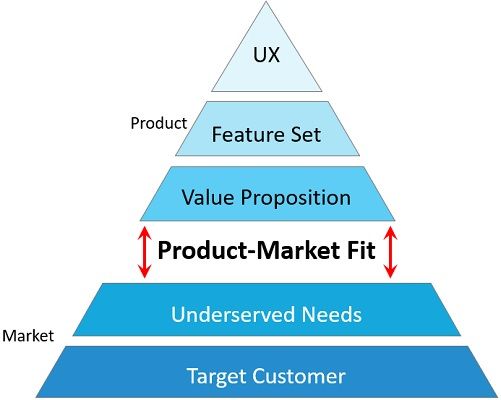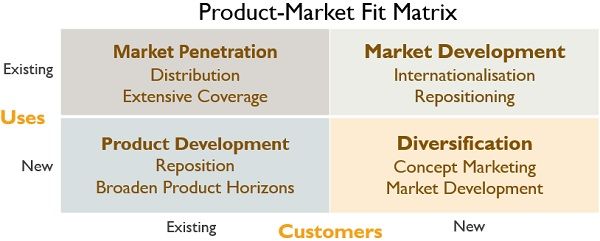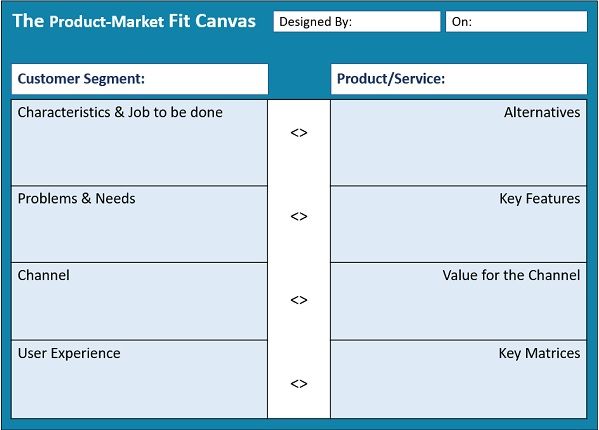Definition: Product-Market Fit is delivering a product that matches the target market requirements. The fit depicts the product’s capabilities to satisfy the overall market demand.
It is one of the marketing strategy models that suggest the future strategic course of action for marketers.
It is a consumer-centric approach and a key to successful entrepreneurship. Here, we examine the product uses in the existing and new markets.

Besides market solutions, it also identifies the customer’s desires and willingness to pay.
By finding the correct fit, the companies can lead their respective markets. Consequently, they remain competitive in the long run.
Components of Product/Market Fit are as follows:
- Good Products
- Ideal Customer
- Effective Marketing
Content: Product-Market Fit
- How to find a product-market fit?
- How is product-market fit measured?
- How to achieve product-market fit?
- Product-Market Fit Canvas
- Advantages
- Example
- Conclusion
How to find a product-market fit?
Achieving the right fit between the product & market is a must for startups and companies. Following are the ways of finding product-market fit:-
- Product-Market Fit Pyramid
- The 40% Rule
- Ansoff Matrix
Product-Market Fit Pyramid
Startups try to find their Product/Market Fit with the help of a pyramid. It helps assess whether companies’ products can satisfy the target market demand.

The pyramid is divided into two broad categories, i.e. product and market. It is then sub-divided into five components:-
- Target Customer
- Underserved Needs
- Value Proposition
- Feature Set
- User Experience (UX)
These components are logically placed in the hierarchy.
Companies must offer products serving the underserved need of the customer. They can reach product-market fit when they serve customers better than their competitors.
The 40% Rule
It is a post-launch market analysis to find out the market fit. The companies analyze their consumer’s preferences by conducting a survey. The products scoring 40% of the surveyed customers who are willing to repurchase are qualified.
It also signifies that the product can meet the market demand. Hence, we can say that the companies have found their product-market fit.
Ansoff Matrix
Ansoff Matrix is a framework that suggests four alternative growth strategies. Matrix dimensions include users (new/existing) and markets (new/existing).
The metrics solve the problem and strive to achieve growth and profitability.

It is a tool for finding and enhancing the fit between a product and its market. Four growth strategies are discussed in detail below:
- Existing Users-Existing Uses (Market Penetration)
- Existing Use-New Users (Market Development)
- New Uses-Existing Users (Product Development)
- New Uses-New Marketers (Diversification)
Existing Users-Existing Uses (Market Penetration)
Firms can use this strategy to boost sales. The strategy is applied among existing customers with the same product. They can focus on product distribution for deeper penetration.
- Making Consumption Mandatory: Companies may make their product consumption mandatory to increase their hold on the market. They can also motivate influencers/decision-makers to buy their product using comparative analysis.
- Switching Intermediaries: The companies can change their distribution patterns to increase their market share. They can follow the customer and make their products available to them.
Existing Use-New Users (Market Development)
Here, the companies offer the current product to new customers. They do not make any changes to the original product. Companies can adopt the following strategies for the same:
- Internationalization: After a while, the product reaches a maturity stage in the existing market. The companies may choose to expand their business internationally. They can find new customers and increase their market share by doing so.
- Positioning: Marketers can analyze consumers’ usage patterns and reposition their products accordingly. Consequently, they can tap a market segment with unique needs.
New uses-Existing Users(Product Development)
Companies need to update their products frequently, even after becoming successful. Marketers keep on modifying their products by adding new features and uses. They modify their products in the following ways:
- Changes in Packaging: Marketers often make changes in packaging and relaunch products to existing customers.
- New Benefits and Situations: Another way to remain successful is by adding new features to the existing products. One can reposition their products with new features and in different situations.
New Uses-New Marketers (Diversification)
In this strategy, marketers explore new products and markets. They try to expand their market segment. Companies conduct a deep survey and deliver a suitable product to reach their market fit.
How is product-market fit measured?
Measuring product-market fit is essential for organizations. The marketer tries to analyse whether their product matches the market demand.
One can measure the fit in both scenarios, i.e. before and after the product launch.
- Understand the target customer’s needs.
- Try to investigate the areas where the competitors are facing difficulties.
- Determine the total revenue from that potential market.
- Calculate the variance between the actual revenue and total revenue. Try to figure out the reasons behind variances.
- Check responses on the ongoing marketing campaigns and reasons for non-engagement.
How to achieve product-market fit?
You can achieve your market fit by aligning your research with the below points:
- Identify the problem.
- Find out the segment and your target customers.
- Investigate customers’ underserved needs.
- Discover the solution best suited for the above problem.
- Design a value proposition, i.e. the product.
- Clearly define and identify Minimum Viable Product (MVP).
- Test the capabilities of the product to satisfy market needs.
Product-Market Fit Canvas
Product/Market Fit Canvas is a tool used to evaluate the actual needs of the target customers. It helps plot and analyze all the vital elements related to the product and consumers.
It is prepared before the product launch and evaluates the actual needs of the target market.

Canvas is divided into two halves, i.e., Customers and Products/Services. It is then subdivided into four parts on each side.
The consumer side of the canvas asks for details about the target customers like:-
- Characteristics and job to be done: Here, we need to analyze the customer’s attributes in detail. And group them into segments and learn their expectations from the product to be offered.
- Problems & Needs: We need to find out the requirements and capabilities of the product to meet these needs.
- Channel: After identifying the needs, we must determine how the product will reach consumers. The distribution channel and accessibility of the product to the ultimate customers.
- User Experience: Here, we review the features of our products that pleased the customers.
Product Side of the canvas, we need to fill in information like:
- Alternative: Firstly, we need to investigate the available alternatives of the product/services. Which product is used by the consumer to fulfil these requirements?
- Key Features: Here, we examine how our product is different from available products. What are the unique features of our product that will satisfy the consumers?
- Value for the Channel: After that, we assess the value of the distribution channel by offering this product.
- Key Matrices: Lastly, we track the product’s performance. The evaluation may be done by analyzing elements like retentions, referrals, etc.
Advantages
It is advantageous to marketers in the following ways:
- It helps to identify and grab untapped markets.
- We can get consumers’ genuine feedback about our product in the entire process.
- It helps in creating value and monopoly in the market.
- It leads to the organic growth of the product.
Example
Monday.com
It is a cloud-based platform that allows its clients to build customized software. They achieved product-market fit by empowering their customers to create tailor-made software.
Spotify
It is a successful media service provider company. Spotify identified that customers are willing to access music online legally by paying a small amount. Hence, it can arrive at its market fit and become a giant in the audio streaming industry.
Conclusion
A fit between the company’s product and its target market’s desires is called Product/Market Fit. Therefore all firms, big or small, strive towards finding and achieving their fit. Through this, they can even achieve a monopoly in their markets and remain profitable in the long run.
Leave a Reply